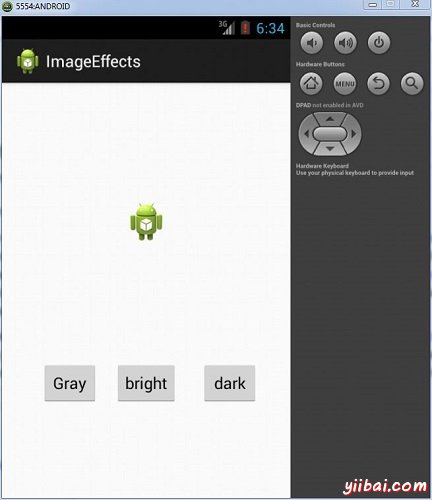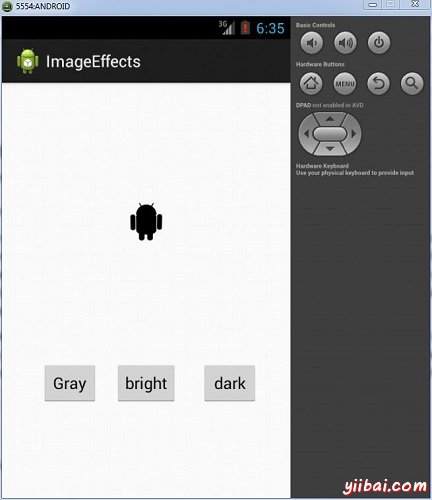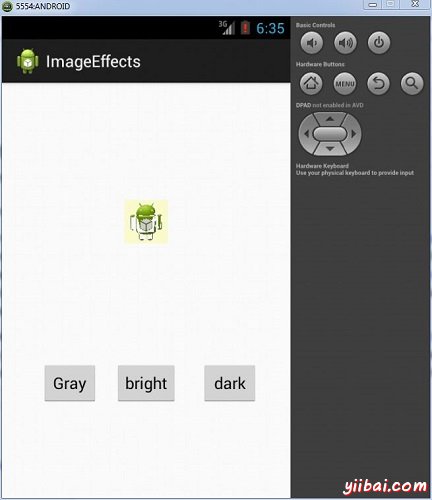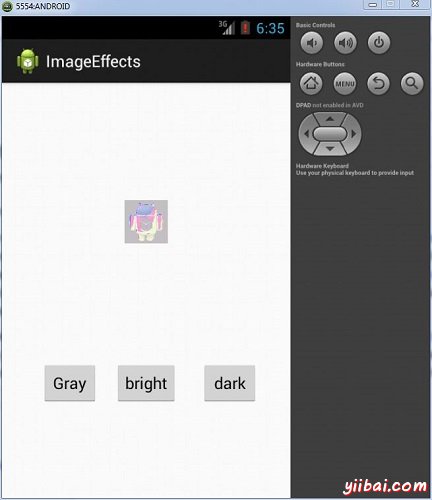Android图片效果
Android的允许通过添加不同种类的处理图像效果。可以轻松地应用图像处理技术来增加某些种类的图像效果。这些影响可能是亮度,黑暗中,灰度转换等
Android提供了Bitmap类来处理图像。这可以在 android.graphics.bitmap 下找到。有很多种方法,通过它可以位图 Bitmap 实例调用。如下创建的图像从ImageView的位图。
private Bitmap bmp; private ImageView img; img = (ImageView)findViewById(R.id.imageView1); BitmapDrawable abmp = (BitmapDrawable)img.getDrawable();
现在,我们将通过调用BitmapDrawable类的getBitmap()函数来创建位图。它的语法如下:
bmp = abmp.getBitmap();
图像不过是一个二维矩阵。同样的方式处理位图。图像由像素组成。所以,从中得到位图的像素并应用处理它。它的语法如下:
for(int i=0; i<bmp.getWidth(); i++){ for(int j=0; j<bmp.getHeight(); j++){ int p = bmp.getPixel(i, j); } }
所述的 getWidth()和 getHeight()函数返回矩阵的高度和宽度。使用getPixel()方法返回像素的指定索引处。得到了像素之后可以根据需要方便地操纵它。
除了这些方法,还有其他方法,帮助我们更好地处理图像。
| Sr.No | 方法及说明 |
|---|---|
| 1 |
copy(Bitmap.Config config, boolean isMutable) 这种方法复制此位图的像素到新位图 |
| 2 |
createBitmap(DisplayMetrics display, int width, int height, Bitmap.Config config) 返回一个可变的位图指定的宽度和高度 |
| 3 |
createBitmap(int width, int height, Bitmap.Config config) 返回一个可变的位图指定的宽度和高度 |
| 4 |
createBitmap(Bitmap src) 从源位图返回一个不可变位 |
| 5 |
extractAlpha() 返回一个新的位图,它捕获原有的alpha值 |
| 6 |
getConfig() 这个方法返回配置,或者返回null |
| 7 |
getDensity() 返回此位图密度 |
| 8 |
getRowBytes() 返回位图的像素字节行之间的数 |
| 9 |
setPixel(int x, int y, int color) 写入指定的颜色成位图(假设它是可变的)在X,Y坐标 |
| 10 |
setDensity(int density) 这种方法指定此位图的密度 |
例子
下面的例子演示了一些对位图上的图像效果。它创建了一个基本的应用程序,让图片转换成灰度等等。
为了试验这个例子,需要在实际设备上运行此程序。
| 步骤 | 描述 |
|---|---|
| 1 | 使用Eclipse IDE创建Android应用程序,并将其命名为 ImageEffects。在创建这个项目时确保目标SDK编译在Android SDK的最新版本或使用更高级别的API。 |
| 2 | 修改 src/MainActivity.java文件中添加必要的代码 |
| 3 | 修改res/layout/activity_main添加相应的XML组件 |
| 4 | 修改res/values/string.xml添加必要的字符串 |
| 5 | 运行应用程序并选择运行Android的设备,并在其上安装的应用和验证结果 |
以下是修改主活动文件的内容src/com.yiibai.imageeffects/MainActivity.java.
package com.example.imageeffects; import android.app.Activity; import android.graphics.Bitmap; import android.graphics.Color; import android.graphics.drawable.BitmapDrawable; import android.os.Bundle; import android.view.Menu; import android.view.View; import android.widget.ImageView; public class MainActivity extends Activity { private ImageView img; private Bitmap bmp; private Bitmap operation; @Override protected void onCreate(Bundle savedInstanceState) { super.onCreate(savedInstanceState); setContentView(R.layout.activity_main); img = (ImageView)findViewById(R.id.imageView1); BitmapDrawable abmp = (BitmapDrawable)img.getDrawable(); bmp = abmp.getBitmap(); } public void gray(View view){ operation= Bitmap.createBitmap(bmp.getWidth(), bmp.getHeight(),bmp.getConfig()); double red = 0.33; double green = 0.59; double blue = 0.11; for(int i=0; i<bmp.getWidth(); i++){ for(int j=0; j<bmp.getHeight(); j++){ int p = bmp.getPixel(i, j); int r = Color.red(p); int g = Color.green(p); int b = Color.blue(p); r = (int) red * r; g = (int) green * g; b = (int) blue * b; operation.setPixel(i, j, Color.argb(Color.alpha(p), r, g, b)); } } img.setImageBitmap(operation); } public void bright(View view){ operation= Bitmap.createBitmap(bmp.getWidth(), bmp.getHeight(),bmp.getConfig()); for(int i=0; i<bmp.getWidth(); i++){ for(int j=0; j<bmp.getHeight(); j++){ int p = bmp.getPixel(i, j); int r = Color.red(p); int g = Color.green(p); int b = Color.blue(p); int alpha = Color.alpha(p); r = 100 + r; g = 100 + g; b = 100 + b; alpha = 100 + alpha; operation.setPixel(i, j, Color.argb(alpha, r, g, b)); } } img.setImageBitmap(operation); } public void dark(View view){ operation= Bitmap.createBitmap(bmp.getWidth(), bmp.getHeight(),bmp.getConfig()); for(int i=0; i<bmp.getWidth(); i++){ for(int j=0; j<bmp.getHeight(); j++){ int p = bmp.getPixel(i, j); int r = Color.red(p); int g = Color.green(p); int b = Color.blue(p); int alpha = Color.alpha(p); r = r - 50; g = g - 50; b = b - 50; alpha = alpha -50; operation.setPixel(i, j, Color.argb(Color.alpha(p), r, g, b)); } } img.setImageBitmap(operation); } @Override public boolean onCreateOptionsMenu(Menu menu) { // Inflate the menu; this adds items to the action bar if it is present. getMenuInflater().inflate(R.menu.main, menu); return true; } }
以下是XML的经修改的内容 res/layout/activity_main.xml.
<RelativeLayout xmlns:android="http://schemas.android.com/apk/res/android" xmlns:tools="http://schemas.android.com/tools" android:layout_width="match_parent" android:layout_height="match_parent" android:paddingBottom="@dimen/activity_vertical_margin" android:paddingLeft="@dimen/activity_horizontal_margin" android:paddingRight="@dimen/activity_horizontal_margin" android:paddingTop="@dimen/activity_vertical_margin" tools:context=".MainActivity" > <Button android:id="@+id/button2" android:layout_width="wrap_content" android:layout_height="wrap_content" android:layout_alignBaseline="@+id/button1" android:layout_alignBottom="@+id/button1" android:layout_alignParentRight="true" android:layout_marginRight="19dp" android:onClick="dark" android:text="@string/dark" /> <Button android:id="@+id/button1" android:layout_width="wrap_content" android:layout_height="wrap_content" android:layout_alignParentBottom="true" android:layout_marginBottom="87dp" android:layout_marginRight="17dp" android:layout_toLeftOf="@+id/button3" android:onClick="gray" android:text="@string/gray" /> <Button android:id="@+id/button3" android:layout_width="wrap_content" android:layout_height="wrap_content" android:layout_alignBaseline="@+id/button2" android:layout_alignBottom="@+id/button2" android:layout_centerHorizontal="true" android:onClick="bright" android:text="@string/bright" /> <ImageView android:id="@+id/imageView1" android:layout_width="wrap_content" android:layout_height="wrap_content" android:layout_alignParentTop="true" android:layout_centerHorizontal="true" android:layout_marginTop="114dp" android:src="@drawable/ic_launcher" /> </RelativeLayout>
以下是res/values/string.xml. 的内容
<?xml version="1.0" encoding="utf-8"?> <resources> <string name="app_name">ImageEffects</string> <string name="action_settings">Settings</string> <string name="hello_world">Hello world!</string> <string name="gray">Gray</string> <string name="bright">bright</string> <string name="dark">dark</string> </resources>
以下是 AndroidManifest.xml 文件的内容
<?xml version="1.0" encoding="utf-8"?> <manifest xmlns:android="http://schemas.android.com/apk/res/android" package="com.yiibai.imageeffects" android:versionCode="1" android:versionName="1.0" > <uses-sdk android:minSdkVersion="8" android:targetSdkVersion="17" /> <application android:allowBackup="true" android:icon="@drawable/ic_launcher" android:label="@string/app_name" android:theme="@style/AppTheme" > <activity android:name="com.yiibai.imageeffects.MainActivity" android:label="@string/app_name" > <intent-filter> <action android:name="android.intent.action.MAIN" /> <category android:name="android.intent.category.LAUNCHER" /> </intent-filter> </activity> </application> </manifest>
让我们试着来运行修改图像效果的应用程序。假设已经创建了AVD在做环境设置。安装程序在AVD并启动它,如果一切设置和应用程序都没有问题,它会显示以下仿真器窗口:

现在,如果看手机屏幕,会看到Android的图像以及三个按钮。
现在,只需选择灰色按钮,将图像转换成灰度和将更新UI。它如下所示:

现在点击光明(bright)按钮,将某个值添加到图像的每个像素,从而使亮度的错觉。它如下所示:

现在轻触dark按钮,将减去某个值的图像的每个像素,从而使暗的错觉。它如下所示:


